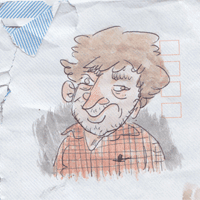Melbourne cartoonist and Smaller Comics Capo Andrew Fulton has launched Minicomic of the Month an initiative to get Australian comics into the hands of readers that might not otherwise be able to find them.
I asked Andrew a few questions about Minicomic of the Month and the folk involved.
If I recall rightly this is the second year of Minicomic of the Month (MOTM)? What was the initial response like? What has it been like this time?
Yeah this is the second time we are doing this - the
first one Pat Grant kicked off in 2009. You can still see his original
pitch here: http://www.patgrantart.
What inspired the use of a subscription format for getting your comics to prospective readers?
The first time sold out pretty much
overnight, so the response was great. I think this time it has been a
little slower, but still a great response, and spread a bit wider too -
we have a larger percentage of international subscribers this time
around, which is great.
Not sure that I can
answer directly to 'inspiration' as I have just stolen Pat's idea, but I
think the subscription is a great way to spread work around. It's a
pretty cheap up front cost from people, there's a sort of energy and
excitement that's different from buying something in a store. And people
probably get a mix of things from people whose work they know, and some
they are less familiar with. And just on a practical level it helps
keeps costs down - you know exactly how many you need to print, you
don't end up with the World's Saddest Cupboard, Overflowing With Unsold
Books.


Pat Grant and Ive Sorocuk


Mandy Ord and Megan Nairn
Are the mini-comics in a uniform format? Are the physical comics produced by each individual creator?
Initially I had thought to do a uniform
format, and kind of centralise the production and logistics of things to
make it a bit easier. But in the early stages of discussion we decided
that that took a little bit of the magic out of it. Part of the fun is
that someone is making this little minicomic with mostly their bare
hands, stapling it up and licking the stamps. There's a personal
connection there.
Is the subscription model for MOTM set at a limited run? Will each installment of Minicomic of the month be mailed from the individual creators?
Yeah, we are planning to limit the subscriptions. We
kind of agreed on 100 being the most we wanted to have to physically
put together and mail. I don't really want it to become a burden, but
also I also know it sold out super quick the first time around and a lot
of people missed out.
And yeah, each month the individual is responsible for getting it together and mailing it out -
although a large chunk of us are in Melbourne so we could get together
for a stapling party or two.
Australian Cartoonists in America: Caravan of Comics
Did you take anything from your experiences on the Caravan of Comics from the American indy/alt/minicomic scene that could be applied to Australia?
The Caravan was
probably the biggest inspiration for getting this thing rolling again,
and kind of sustain that momentum of getting Australian Comics out into
the world. It's kind of a downer but one of the big things I
"took" from the Caravan was a reminder of how far away we are from
everything. There's a much larger audience for our work that it's not
all that easy to connect with from here, Facebook and Twitter and all
that aside - $5 shipping on a $3 or whatever is kind of a hard sell. And
I guess even worse if someone wants one of my books and one of yours,
that's even worse maths. I think I may have lost my point in here. I
guess it's maybe that giving people a single point Get a bunch of things
from different people at once is a way to combat that? But
then, in some ways the answer to that is digital distribution- sensibly
we should be doing something like this as ebooks or whatever? Forget
about distance. But that comes back to what I was saying about magic.
It's the personal touch or whatever that makes a project like this work.
Some of the creators involved in MOTM have books
published through large above ground publishers, What do you think is the appeal in producing comics at a minicomic scale?
You'd probably have to ask someone like Pat or Mandy, but again I think it is
about the personal touch, about being able to do something quickly and
send it out directly to your audience. It's not something you have to
spend years toiling over, it's quick, dirty and fun.
Images © 2012 respective artists.
























































